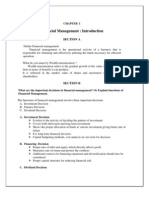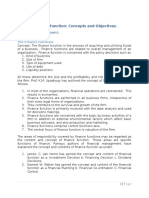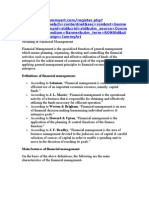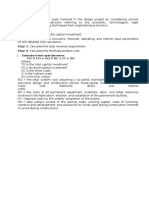0 ratings0% found this document useful (0 votes)
1 viewsFM-MBA-FM-BI-BE - Unit-1-1
FM-MBA-FM-BI-BE - Unit-1-1
Uploaded by
Utkarsh AgnihotriMBA FM Unit 1
Copyright:
© All Rights Reserved
Available Formats
Download as PDF, TXT or read online from Scribd
FM-MBA-FM-BI-BE - Unit-1-1
FM-MBA-FM-BI-BE - Unit-1-1
Uploaded by
Utkarsh Agnihotri0 ratings0% found this document useful (0 votes)
1 views21 pagesMBA FM Unit 1
Original Title
FM-MBA-FM-BI-BE- Unit-1-1
Copyright
© © All Rights Reserved
Available Formats
PDF, TXT or read online from Scribd
Share this document
Did you find this document useful?
Is this content inappropriate?
MBA FM Unit 1
Copyright:
© All Rights Reserved
Available Formats
Download as PDF, TXT or read online from Scribd
Download as pdf or txt
0 ratings0% found this document useful (0 votes)
1 views21 pagesFM-MBA-FM-BI-BE - Unit-1-1
FM-MBA-FM-BI-BE - Unit-1-1
Uploaded by
Utkarsh AgnihotriMBA FM Unit 1
Copyright:
© All Rights Reserved
Available Formats
Download as PDF, TXT or read online from Scribd
Download as pdf or txt
You are on page 1of 21
MBAFM/BI/BE-6214
Financial Management
January-May: 2023
Dr. Shambhu Nath Singh
Associate Professor (Economics & Finance)
Department of Banking, Economics & Finance
Bundelkhand University, Jhansi
Syllabus: Financial Management
Unit I: Nature of Financial Management: Concepts and
Objectives of Financial Management; Approaches of
Financial Management.
Unit II: Time Value of Money, Valuation of Securities, Risk
and Return, Beta Estimation, Cost of Capital.
Unit III: Investment Analysis: Capital Budgeting Decisions,
Determining Cash Flow for Investment Analysis, Complex
Investment Decision and Risk Analysis in Capital Budgeting
Unit IV: Capital Structure: Instruments of Long and short
term sources of funds, Capital Structure Theories, Leverages
Analysis, Dividend Theories and Policies
Unit V: Working Capital Management Concepts and its
Types, Estimation of Working Capital, Determinants of
Working Capital, Credit Policy, Receivable Management,
Cash Management, Marketable Securities, Inventory
Management;
Unit -1 Financial Management
Meaning, Nature and Scope of Financial
Management
Objective of Financial Management
Approaches of Financial Management
Investment Decision, Financing Decision
and Dividend decisions
Financial Goal- Profit versus Wealth
Maximization
Finance
Money required for any activity is known as
finance. Every activity whether economic or non
economic requires money to run it.
The activity related to production, distribution,
exchange and consumption of goods and services is
known as economic activity. For example- a worker
works in a factory and gets the wages.
The human activities which are not performed for
expectation of money or money’s worth are called
non- economic activities. For example- a person
goes to temple, a boy help his friend in studies etc.
Finance is defined as the provision of money at the
time when it is required.
Financial Management
Finance is required not only to start the
business but also to operate it, to expand or
modernise its operations and to secure stable
growth.
Thus financial management refers to that part
of management activity which is concerned
with the planning and controlling of firm’s
financial resources. It deals with finding out
various sources for raising funds for the firm.
The sources must be suitable and economical
for needs of the business.
Nature of Financial Management
1. It is essential part of management. It is an
integral part of business decision making process.
2. It is a continuous process.
3. It is centralised nature of finance function i.e.
investment, financing and dividend decision.
4. It helps in the decision making of top
management.
5. It helps in measurement of performance of
business.
6. It has wide scope and all form of business
organisation; either big or small needs to manage
finance.
Importance of Financial Management
1. Financial planning and successful promotion of
an enterprise
2. Acquisition of funds and when required at the
minimum possible cost
3. Proper use and allocation of funds
4. Taking the sound financial decisions
5. Improving the profitability through financial
controls
6. Increasing the wealth of the investors and the
nation; and
7. Promoting and mobilising individual and
corporate savings.
Approaches of Financial Management
The approaches of financial
management can be divided
into two categories-
1.The Traditional Approach
2.The Modern Approach
The Traditional Approach
The traditional approach was used in initial stages of its evolution
during 1920s and 1930s when the term corporate finance was used
to describe the financial management.
According to this approach, the scope of finance function was only
the procurement of funds needed by a business. The traditional
approach has been discarded due to many limitations:
1. It considers only external decision making and ignores internal
decision making as to the proper utilisation of funds.
2. The focus of traditional approach was on procurement of long
term funds. Thus, it ignores the decisions of working capital
management.
3. The issue of allocation of funds, which is so important today, is
completely ignored.
4. It does not focus on day to day financial problems of an
organisation.
The Modern Approach..
The modern approach covers the finance function
in broader sense.
It includes procurement of funds as well as their
effective utilisation.
The cost of raising funds and the returns from their
use should be compared.
The funds raised should be able to give more
returns than the cost involved in procuring them.
The modern approach considers the three basic
management decisions i.e. investment decisions,
financing decisions and dividend decisions within
the scope of finance function.
The Modern Approach...
The Modern Approach...
Objective of Financial Management
The objective of financial management
may be-
1. To maximise profit
2. To maximise earning per share
3. To maximise market share
4. To maximise the current value of the
company’s stock
5. To minimise costs
Scope of Financial Management
The main objective of financial management is to arrange
sufficient finances for meeting short term and long term
needs. These funds are procured at minimum costs so
that profitability of the business is maximised. With
these things in mind, a financial manager will have to
concentrate on the following areas of finance functions-
1. Estimating Financial Requirements
2. Deciding Capital Structure
3. Selecting a source of Finance
4. Selecting a Pattern of Investment
5. Proper Cash Management
6. Implementing Financial Controls
7. Proper use of Surpluses
Financial Goal
Profit versus Wealth Maximization
The main objective of a business is to
maximise the owner’s economic
welfare. This objective can be
achieved by-
1. Profit Maximisation, and
2. Wealth Maximisation
Profit Maximisation
It is considered as the main objective of business. Though it is
the main objective but it has been criticised on many grounds.
Sometimes, a firm pursing the objective of profit maximisation
starts exploiting workers and consumers. Hence it is unethical
and leads to a number of corrupt practices.
It is argued that profit maximisation should be the objective in
the conditions of perfect market competition, but in today
scenario there is no perfect market competition.
A company is financed by shareholders, creditors and financial
institutions and is controlled by professional managers.
Workers, customers, government and society also concerned
with it. So, one has to reconcile the conflicting interests of all
these parties concerned with the firm.
Thus, profit maximisation as an objective of financial
management has been considered inadequate.
Wealth Maximisation
Wealth maximisation is the appropriate objective
of the firm.
Financial theory proved that wealth maximisation
is the single substitute of a stockholder’s utility.
When the firm maximises the stockholder’s
wealth, the individual stockholder can use this
wealth to maximise his individual utility.
It means that by maximising stockholder’s wealth
the firm is operating towards maximising
stockholder’s utility.
A stockholder’s current wealth in the firm =number
of shares owned*current stock price per share.
Profit versus Wealth Maximisation
Profit Maximisation versus Wealth Maximisation
S.No. Profit Maximisation Wealth Maximisation
1. It does not take into It takes into account the
account the time value time value of money.
of money.
2. It does not take into It takes into
consideration the consideration the risk
uncertainty of future factor.
earnings.
3. It does not cosider the It cosiders the effect of
effect of dividend dividend policy on
policy on market price market price of shares.
of shares.
4. It does not It considers the different
differentiate between strategies for long term
short term and long and short term profits.
term profits.
Functional Areas of Financial Management
The important functional areas of financial
management are as follows-
1. Determining Capital Needs
2. Selecting the Sources of Funds
3. Financial Analysis and Interpretation
4. Cost-Volume-Profit-Analysis
5. Capital Budgeting
6. Working Capital Management
7. Profit Planning and Control
8. Dividend Policy
With the Best Compliments
Thanking to all…..
By
Dr. Shambhu Nath Singh
Associate Professor
(Former District Economic & Statistical Officer)
M. Sc. (Physics), MBA (Finance), MA (Economics)
JRF in Management, NET in Economics
Coordinator Ph. D. Coursework
Bundelkhand University, JHANSI
Mobile-09450075770; 08299233527 (WhatsApp)
Email-drsnsinghbujhansi@gmail.com
Unit 1 is over.
Thank You so much....
Dr. Shambhu Nath Singh
You might also like
- Introduction To Financial ManagementDocument23 pagesIntroduction To Financial ManagementLifeatsiem Rajpur100% (7)
- Cost Quizlet 2Document7 pagesCost Quizlet 2agm25No ratings yet
- Organisational Behavior - NotesDocument21 pagesOrganisational Behavior - NotesLakshya Tanwar93% (15)
- Environmental History, Politics, and Economics: Lecture Notes 3Document8 pagesEnvironmental History, Politics, and Economics: Lecture Notes 3Princess NobleNo ratings yet
- Project ReportDocument13 pagesProject ReportgraciousNo ratings yet
- FM MBA Study MaterialDocument28 pagesFM MBA Study MaterialJayakrishnan Pillai100% (2)
- UNIT 1: Introduction of Financial Management: New Law College, BBA LLB 3 Yr Notes For Limited CirculationDocument15 pagesUNIT 1: Introduction of Financial Management: New Law College, BBA LLB 3 Yr Notes For Limited CirculationSneha SenNo ratings yet
- Chapter:-1: Introduction of Financial ManagementDocument75 pagesChapter:-1: Introduction of Financial Managementsn8080No ratings yet
- LOANSS AND ADVANCES - Complete-1Document93 pagesLOANSS AND ADVANCES - Complete-1Imam AnnigeriNo ratings yet
- 2 Financial Management Unit 1Document16 pages2 Financial Management Unit 1krangaswamy5897No ratings yet
- Micro Finance: Ii Sem McomDocument46 pagesMicro Finance: Ii Sem McomRekha MadhuNo ratings yet
- Unit-1 Updated (Financial Management)Document25 pagesUnit-1 Updated (Financial Management)kingpandatsharmaNo ratings yet
- Bba 4 Semester-Financial Management: Unit I Nature of Financial Management - Notes 1 Topics IncludedDocument25 pagesBba 4 Semester-Financial Management: Unit I Nature of Financial Management - Notes 1 Topics IncludedHimanshu KonwarNo ratings yet
- Financial Management 1Document29 pagesFinancial Management 1Aŋoop KrīşħŋặNo ratings yet
- Financial management note2024Document63 pagesFinancial management note2024thomaslomoro55No ratings yet
- Mba Ii Sem Finacial ManagementDocument11 pagesMba Ii Sem Finacial ManagementningegowdaNo ratings yet
- Gikondo Rusizi - Ur - Cbe Managerial Finance Notes April 2023 April 2023Document324 pagesGikondo Rusizi - Ur - Cbe Managerial Finance Notes April 2023 April 2023Cyiza Ben RubenNo ratings yet
- FM Unit IDocument15 pagesFM Unit ILakshmi RajanNo ratings yet
- FinanceDocument15 pagesFinanceGuptaji gamingNo ratings yet
- Unit 1 NotesDocument15 pagesUnit 1 NotesSrujana ShettyNo ratings yet
- Unit 1Document9 pagesUnit 1E11Ayush MinjNo ratings yet
- 01 Financial ManagementDocument84 pages01 Financial ManagementNambi RajanNo ratings yet
- Jamia Millia Islamia New Delhi: An Assignment On: Financial ManagementDocument8 pagesJamia Millia Islamia New Delhi: An Assignment On: Financial ManagementAnonymous XVUefVN4S8No ratings yet
- FM 35Document38 pagesFM 35Dhanalakshmi MurugesanNo ratings yet
- UntitledDocument3 pagesUntitledZeyNo ratings yet
- Q. Introduction, Meaning and Definition of Financial Management?Document8 pagesQ. Introduction, Meaning and Definition of Financial Management?Rizwana BegumNo ratings yet
- Sudheer ProDocument82 pagesSudheer ProNaveen RamdevuNo ratings yet
- Unit 1 Introduction To Financial ManagementDocument9 pagesUnit 1 Introduction To Financial ManagementSanskari RoushanNo ratings yet
- International Journal of Business and Management Invention (IJBMI)Document5 pagesInternational Journal of Business and Management Invention (IJBMI)inventionjournalsNo ratings yet
- FM - Ramesh Sirs PortionDocument13 pagesFM - Ramesh Sirs PortionTejas DesaiNo ratings yet
- Sbaa 3004Document71 pagesSbaa 3004mohanrajk879No ratings yet
- Meaning, Scope & Objectives of Financial ManagementDocument3 pagesMeaning, Scope & Objectives of Financial ManagementAmanDeep SinghNo ratings yet
- Financial ManagementDocument12 pagesFinancial ManagementHarshitha Angel.B100% (1)
- FM Unit 1Document41 pagesFM Unit 1KarishmaNo ratings yet
- Unit 1 Introduction of FinanceDocument53 pagesUnit 1 Introduction of FinanceMalde KhuntiNo ratings yet
- Introduction To Financial Management: Unit IDocument37 pagesIntroduction To Financial Management: Unit IkunalNo ratings yet
- FM CuDocument268 pagesFM CuDRISYANo ratings yet
- Final Financial ManagementDocument110 pagesFinal Financial ManagementKALASH INTERNATIONALNo ratings yet
- Financial Management Module I: Introduction: Finance and Related DisciplinesDocument4 pagesFinancial Management Module I: Introduction: Finance and Related DisciplinesKhushbu SaxenaNo ratings yet
- Bba FM Notes Unit IDocument15 pagesBba FM Notes Unit Iyashasvigupta.thesironaNo ratings yet
- Financial ManagementDocument17 pagesFinancial ManagementPallavi SharmaNo ratings yet
- FM Unit-1Document9 pagesFM Unit-1Aam aadmiNo ratings yet
- Unit 1 FMDocument42 pagesUnit 1 FMASHISH KUMARNo ratings yet
- Financial Management Financing Decision Investment Decision Dividend DecisionDocument5 pagesFinancial Management Financing Decision Investment Decision Dividend Decisionjagdish makwanaNo ratings yet
- Chap 1. Financial Management 1.1 Finance and Related DisciplineDocument13 pagesChap 1. Financial Management 1.1 Finance and Related DisciplineBarkkha MakhijaNo ratings yet
- Financial ManagementDocument8 pagesFinancial Managementmandeep_kaur20No ratings yet
- Aims of Finance FunctionDocument56 pagesAims of Finance FunctionBV3S100% (2)
- Working Capital Dodly DairyDocument90 pagesWorking Capital Dodly DairyRAKESHNo ratings yet
- BSNL Project 2Document79 pagesBSNL Project 2Naveen RamdevuNo ratings yet
- Financial ManagementDocument11 pagesFinancial ManagementrickxavicNo ratings yet
- FM Notes 1Document78 pagesFM Notes 1Amol MahajanNo ratings yet
- Chapter 1: Overview: Classification of FinanceDocument8 pagesChapter 1: Overview: Classification of Financesufian pabelNo ratings yet
- Chapter 1: Overview: Classification of FinanceDocument8 pagesChapter 1: Overview: Classification of Financesufian pabelNo ratings yet
- Financial Management One CH OneDocument33 pagesFinancial Management One CH Oneabdussemd2019No ratings yet
- Financial Management Full Lecture Till Mid TermDocument39 pagesFinancial Management Full Lecture Till Mid TermFauzia AfrozaNo ratings yet
- Fundamentals of Financial ManagementDocument131 pagesFundamentals of Financial ManagementDhanraj MoreNo ratings yet
- Unit 1Document13 pagesUnit 1arispatowary77No ratings yet
- Introduction To Financial ManagementDocument29 pagesIntroduction To Financial Managementraymundojr.junioNo ratings yet
- Importance and Scope of Financial ManagementDocument15 pagesImportance and Scope of Financial Managementvirkstatus16No ratings yet
- Financial Literacy for Entrepreneurs: Understanding the Numbers Behind Your BusinessFrom EverandFinancial Literacy for Entrepreneurs: Understanding the Numbers Behind Your BusinessNo ratings yet
- Business CycleDocument29 pagesBusiness Cyclesamrulezzz100% (1)
- Budget Line & Revealed Preference - Prof .Harshad SambhusDocument4 pagesBudget Line & Revealed Preference - Prof .Harshad SambhusHitesh SinghNo ratings yet
- PGDM 22 24 MacroeconomicsDocument11 pagesPGDM 22 24 MacroeconomicsAnimesh Verma-1 8 3 0 1No ratings yet
- Applied EconomicsDocument47 pagesApplied EconomicsRoe SupnetNo ratings yet
- Buyers Sellers VolumeDocument8 pagesBuyers Sellers Volumesandip_exlNo ratings yet
- IFM QuizletsDocument5 pagesIFM QuizletsKriti MajumdarNo ratings yet
- SSRN Id2015273 PDFDocument18 pagesSSRN Id2015273 PDFkarim lehroucheNo ratings yet
- Modren Quantity Theory of Money Ugc Net Economics IAS Economics Mains Ma Entrance Econ9micsDocument7 pagesModren Quantity Theory of Money Ugc Net Economics IAS Economics Mains Ma Entrance Econ9micsNaresh SehdevNo ratings yet
- Chap5 2Document44 pagesChap5 2Ngoc Diep NguyenNo ratings yet
- Absorption Costing Reconciliation StatementDocument4 pagesAbsorption Costing Reconciliation Statementali_sattar15No ratings yet
- Editor-in-Chief: Prof. (DR.) Syed Haider AliDocument68 pagesEditor-in-Chief: Prof. (DR.) Syed Haider AliGaurav GaggarNo ratings yet
- Politics, Economics, and Welfare Planning and Politico-Economic Systems Resolved Into Basic Social Processes (Robert A. DAHL, Charles E. LINDBLOM)Document574 pagesPolitics, Economics, and Welfare Planning and Politico-Economic Systems Resolved Into Basic Social Processes (Robert A. DAHL, Charles E. LINDBLOM)Christine Andrea JazminNo ratings yet
- Chapter 1 - Thinking Like An EconomistDocument2 pagesChapter 1 - Thinking Like An Economistbot2070% (1)
- Assessment #2 Elasticity Concepts (Answer Key)Document3 pagesAssessment #2 Elasticity Concepts (Answer Key)Jocelyn LooNo ratings yet
- Rabobank Global Dairy Outlook November2010 02Document36 pagesRabobank Global Dairy Outlook November2010 02alextapuNo ratings yet
- STEEP Analysis TemplateDocument10 pagesSTEEP Analysis TemplateMohammed ABDO ALBAOM100% (1)
- Midterm Exam NotesDocument3 pagesMidterm Exam NotesCalystra LNo ratings yet
- Automotive Thesis ExampleDocument6 pagesAutomotive Thesis Examplednqjxbz2100% (2)
- Economic Analysis: Tci Fci + Oo DC + Ic + OoDocument3 pagesEconomic Analysis: Tci Fci + Oo DC + Ic + OoAlexander VovaNo ratings yet
- ECON 306 Midterm Review-1Document6 pagesECON 306 Midterm Review-1Chandler SchleifsNo ratings yet
- Central Bank Governance and Oversight Reform, Edited by John H. Cochrane and John B. TaylorDocument73 pagesCentral Bank Governance and Oversight Reform, Edited by John H. Cochrane and John B. TaylorHoover InstitutionNo ratings yet
- Tutorial 1Document2 pagesTutorial 1Silo KetenilagiNo ratings yet
- TestBank Chapter-01Document78 pagesTestBank Chapter-01sbossmanNo ratings yet
- Sunk Cost FallacyDocument28 pagesSunk Cost FallacyJonathanChanNo ratings yet
- 4 - Shrayan SarkarDocument6 pages4 - Shrayan SarkarKunal DagaNo ratings yet
- Literature Study-Transportation CostDocument22 pagesLiterature Study-Transportation CostsulthanhakimNo ratings yet
- CH 5 Market StructureDocument33 pagesCH 5 Market StructureEstifanos DefaruNo ratings yet

























































































